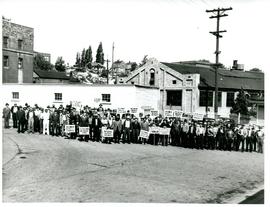Anderson, Ada Woodruff
Ada Woodruff Anderson was a Pacific Northwest writer and early resident. Born in San Francisco on July 4, 1860, her family moved to Shanghai, China, when she was three months old. She arrived in Tumwater, Washington, in 1865 after her father died. There her family lived with her mother’s brother, Nathaniel Crosby, grandfather of Bing Crosby. She attended high school in San Francisco, California, and returned to Washington around 1875. In 1879 she began teaching at a one-room pioneer school in Thurston County near Yelm. She married Oliver Phelps Anderson in 1882 and they had three children; Alice Woodruff (1882-1972), also a writer of short stories, Maurice Phelps (1888-1970), and Dorothy Louise (1893-1912).
While still in high school, she entered a story writing contest sponsored by the San Francisco Chronicle at the urging of a friend and won second prize. In 1899, her husband began to produce photographic essays for magazine publication and asked Ada to write the accompanying copy. She began to produce short stories which were published in a variety of magazines, and she considered her best work during this period to be “The Man Who Knew Bonner” (Harper’s September 1902).
She drew upon her early teaching experience in her first novel, The Heart of the Red Firs (1908). Her second novel, The Strain of White (1909), is set in Washington Territory in the 1850s during the time of the treaty councils. The Rim of the Desert (1915) interwove settings in Alaska, Seattle, and Wenatchee, including the historical 1910 Wellington disaster, when an avalanche swept away two trains in the Cascade mountains.
She apparently ceased writing for publication afterward, lived on Bainbridge Island, and assisted with the family business, the Anderson Supply Company. She died March 23, 1956 in Port Blakely, Kitsap County.
Anderson, Oliver Phelps
Oliver Phelps Anderson was an early Seattle, Washington mapmaker, surveyor, photographer, and owner of a photographic supply business. Born in Lexington, Illinois in 1859, his family had moved to Oregon by 1869, where his father, Alexander Jay Anderson was Dean of the Academy at Pacific University in Forest Grove. He had an eclectic early education, studying bookkeeping, chemistry, and the pharmaceutical business, in Portland, Oregon. From 1878-1880, he attended the University of Washington, where by this time his father had been appointed President (1877-1882). He established a mapmaking business in Seattle and was an early adopter of the cyanotype photographic process to quickly produce maps and blueprints. He founded the Anderson Supply Company in his mapmaking offices in 1898 and it moved to 111 Cherry St in Seattle by 1899.
He married Ada Woodruff on January 4, 1881. He produced photographic essays for publication, one on Kwakiutl basketmakers of Vancouver Island, and at least two on scenic views of the Cascade mountains, and asked her to write accompanying descriptions. He died April 15, 1941 on Bainbridge Island
Anderson, Maurice Phelps
Maurice Phelps Anderson was the second child and the only son born to Ada and Oliver Anderson on June 9, 1888. He graduated from the Massachusetts Institute of Technology in 1910 with a degree in naval architecture. He kept a diary of his experiences in the US Army in WWI, where he served in optical supply procurement for the Ordinance Department. He wrote short stories and novels, possibly never published
He and a partner, Fred Norton Hallett, were granted a patent in 1926 for a lens system. He worked at the Anderson Supply Company, becoming president around 1913 and continuing in this role until the company closed in the late 1950s.
Anderson Supply Company
Anderson Supply Company was a photographic supply business in downtown Seattle. It was founded in 1899 by Oliver Phelps Anderson in his map-making offices and moved to 111 Cherry St in 1900. Along with photographic supplies and lenses, it sold scenic photographs of the Northwest. Both Ada Woodruff Anderson and their son Maurice Phelps Anderson were employed there in various capacities. Maurice took over as president in 1913 and remained throughout the existence of the business, which ended in the late 1950s.
McGrew, J. E.
J. E. McGrew is thought to be James E. McGrew, a Seattle attorney. He was born in Iowa in 1858 and had arrived in Seattle by 1892. His connection to the Anderson family is unknown.
